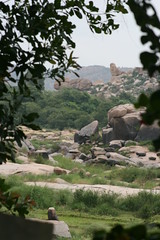 The hills are topped with rocks, the valleys are green, and there is a beautiful river meandering through the valley. The area is bordered on onside by hills, and the other by the river. This made it a nicely defensible spot when it was established as a kingdom. Today much of the agricultural land is in bananas or sugar cane. The closest town, or maybe really city, is Hospet is 10K away. That is where our hotel was. Hospet has around 400K people, or so we were told. The part we saw was rather unremarkable, other than there is still a lot of agricultural influence. We saw many carts drawn by cows, or similar creatures. There was even a couple of animals which looked like white cows, but they had large pink and green spots all over them. I did ask the driver why, but couldn't really understand his answer other than something about special. I assume they had been recently blessed, or were just decorated like so many other things in India. Many of the cows get decorated, mostly by painting their horns.
The hills are topped with rocks, the valleys are green, and there is a beautiful river meandering through the valley. The area is bordered on onside by hills, and the other by the river. This made it a nicely defensible spot when it was established as a kingdom. Today much of the agricultural land is in bananas or sugar cane. The closest town, or maybe really city, is Hospet is 10K away. That is where our hotel was. Hospet has around 400K people, or so we were told. The part we saw was rather unremarkable, other than there is still a lot of agricultural influence. We saw many carts drawn by cows, or similar creatures. There was even a couple of animals which looked like white cows, but they had large pink and green spots all over them. I did ask the driver why, but couldn't really understand his answer other than something about special. I assume they had been recently blessed, or were just decorated like so many other things in India. Many of the cows get decorated, mostly by painting their horns.Traveling through the area to Hampi, it is obvious that the whole countryside is littered with temples, litterally hundreds or thousands of them, both current and old, both in use and decrepit. At one point I asked why so many. Many of them are all to one god, the king's favorite, Vishnu. But many others are there because of two reasons. One, too many people for one temple to handle. Two, many people would prefer to pray to a different god. So there you have it-a landscape covered in Rocks and Rock Temples.
Anyways. We proceeded from Hospet to Hampi, and along the way we picked up our guide. Unfortunately I don't have his name, but he was excellent. He had been trained by the archeological department and knew all kinds of interesting facts and figures about the places we were going to see. I won't tell about each and every temple we saw, nor all of the statues he described. Suffice it to say that it is an impressive place. You will have to look at the photos to get an idea, but to really appreciate it, you have to go there. It is one of those places which cannot be captured in words or pictures. It demands to be experienced.
We started with Hemakuta Hill and Temples, and then went on to the main temple known as Hampi, or Virupaksha Temple. Following that we saw the active bazaar, which is built where one of the original bazaars was. It is about 1/3 as long as the original one, which is about ½ kilometer long, I think. There we saw a wooden chariot which is used in the Hampi festival each year. It resembles the stone one we saw the next day.
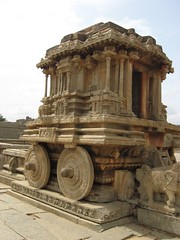 The whole area was built up as a Hindu kingdom in response to some Muslim activities further to the north. It was built starting in the 1300s and was finally sacked in late 1500s. Much of what is visible today is broken or damaged during the final invasion. It is a real shame, seeing some of what is still there, one can only imagine how splendorous it was at the time.
The whole area was built up as a Hindu kingdom in response to some Muslim activities further to the north. It was built starting in the 1300s and was finally sacked in late 1500s. Much of what is visible today is broken or damaged during the final invasion. It is a real shame, seeing some of what is still there, one can only imagine how splendorous it was at the time. After the main temple, we went and had lunch at the Mango Tree Restaurant. This was a lovely place, where you arrive by footpath through the banana plantation. At the entrance you remove your shoes, and then go ‘in’. The actual eating area is on terraces going down towards the river, with stone tables built into them. Mostly people sit facing the river, with a serene and idyllic view. I had to laugh when I think about the signs in the us that ‘shirt and shoes are required’ in eating places, here we had to take our shoes off to get into the restaurant, and it is considered unclean to wear footwear inside…
In the afternoon we went to the mint. This is an area which was surrounded by high stone walls, with watchtowers
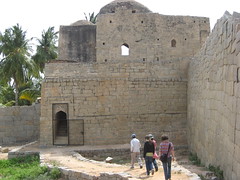 , and held the valuables. It was also where much of the money was either kept or made. It is really hard to describe adequately. Please look at the pictures. We spent some time in the watchtower
, and held the valuables. It was also where much of the money was either kept or made. It is really hard to describe adequately. Please look at the pictures. We spent some time in the watchtower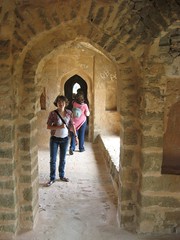 , and then wandered around the ruined buildings. We did see pictures taken in the 1800s by an Englishman. In some cases it is amazing to see how overgrown some areas were in that time, and how they’ve been cleaned up by the government since then. There was a major cleaning/excavation in the 1970’s. Several unknown buildings/structures/baths were uncovered which had previously been hidden. They also used some photos to do restoration in some cases. Here you can see part of the entrance to the temple area which has been restored according to the old photograph. You can get an idea of what it all looked like.
, and then wandered around the ruined buildings. We did see pictures taken in the 1800s by an Englishman. In some cases it is amazing to see how overgrown some areas were in that time, and how they’ve been cleaned up by the government since then. There was a major cleaning/excavation in the 1970’s. Several unknown buildings/structures/baths were uncovered which had previously been hidden. They also used some photos to do restoration in some cases. Here you can see part of the entrance to the temple area which has been restored according to the old photograph. You can get an idea of what it all looked like. All day long we were looking at the amazing carvings on the walls, pillars, doors etc. Here is a small collection of them.





Because of the train ride, we cut Saturday a bit short, and decided to head out early on Sunday to see more. It was the right decision as we were all pretty tired by the time we got back to the hotel. More later.
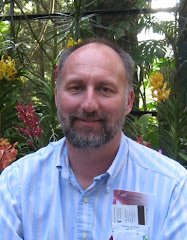
1 comment:
I already told Cindy this, but when I come visit: I want to go to Hampi! So put that on your calendar!
Love
M
Post a Comment